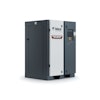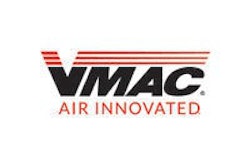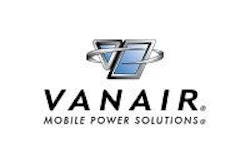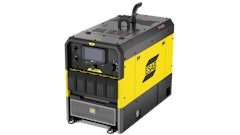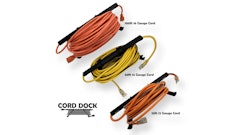Choosing a truck-mounted compressor can be confusing. There are under-hood, under-deck and above-deck units. There are both rotary screw and reciprocating piston pump airends, and the units can be driven by a belt, PTO, hydraulic motor and internal combustion engine. In addition, there have been advancements in design. Yet, the most important place to start is still with your air demands.
Size it right
"The most important consideration to understand when determining the right truck-mounted compressor is the application in which it will be used," says Tim Worman, product manager - commercial vehicles, Iowa Mold Tooling (IMT). "What types of tools will you be running and how much air and pressure do you need to run them? Also, you need to consider how many tools you will be running and how often air will be needed. If air is needed constantly, then a rotary screw compressor would be the best option."
Start by asking yourself what you will be doing with the compressor to ensure you won't overwork it. "For example, if you're running a 1-in. impact wrench 80% of the time, you would be overworking a 35-cfm compressor," notes Worman. "Sure you could run it that way, but it would be inefficient, because you would cycle the compressor more and would waste time while the air tank is refilling. In that application, you would probably want to have an air compressor that has a higher cfm rating for the job at hand."
But undersizing is usually not the problem. "If there is a common mistake, customers tend to oversize the unit," says Dan Kokot, executive vice president, Vanair. Most pneumatic tools are rated at 90 to 110 psi. Delivering higher pressures to the tools than required will only shorten tool life.
Oversizing can also impact the compressor's longevity. "If you buy a compressor that is too large, you actually don't work it hard enough," says Chris Lamb, truck-mounted equipment product support & training, Doosan Infracore Portable Power. "If it is never really loaded, you don't build up enough heat to evaporate the moisture. It can shorten the life cycle."
According to Todd Dufur, strategic accounts, Doosan Infracore Portable Power, this inability to achieve the desired operating cycle can also lead to trouble with the air/oil separation system that removes the compressor oil (used to lubricate the system) from the compressed air. "With the compressor, you really want to have good separation," he states. "If you are not using it, you are going to have poor separation, or oily air."
Take a close look at the tools you use to determine the proper air flow and pressure required, says Dan Hutchinson, product management specialist, VMAC. "Also important is the duty cycle needed. You can plan for 100% duty cycle for rotary screw compressors, but only 40% to 80% for piston compressors," he explains.
The operating environment plays a role, as well. "The harsher the environment (temperature, contamination), the more important it is that the system be protected," says Hutchinson. Measure the impact of the system's size and weight against the need to maximize the amount of cargo capacity, as well as the size of the truck and feasibility of a compressor installation on that platform. "The other requirements of the truck - such as the need for hydraulics - must also be considered."
Save space
"With an under-hood or under-deck air compressor system, the most significant advantage is that it frees up deck space," says Hutchinson. "Typically, there is also a reduction in the weight of the compressor, which translates into fuel savings and environmental benefits.
"The most notable drawback for under-hood compressors - a facet that most customers are unaware of - is that the research and development process for these compressors must be started much earlier because of the complexity in design," he continues. "Manufacturers like VMAC work with the OEM truck manufacturers long before truck prototypes are even produced in order to ensure the equipment is available as the truck models come to market."
The truck engine powers the compressor, usually through a serpentine belt, so there is no additional engine to maintain or fuel required.
"In modern under-hood compressor systems, the engine speed is regulated directly proportional to air need. This saves both fuel and engine wear and cuts down noise and exhaust emissions," Hutchinson points out. "Advanced under-hood technology scheduled to be released later this year will even control the truck engine by turning it off when air is not being used, and then automatically restarting it when air is used again. This will reduce truck engine idling time, ultimately improving fuel economy, decreasing engine operating hours, lowering truck emissions, reducing noise levels and cutting life-cycle costs."
The units are also more protected from external conditions. "Deck-mounted systems are not shielded from the elements," says Hutchinson.
Under-deck systems provide greater capacity. "Under-deck systems can usually provide more air, but there can be challenges mounting the systems. There are typically no truck-specific kits and universal kits often need fabrication," Hutchinson notes. "Also, under decks tie up a PTO port that may be required for other uses. Finally, under-deck compressors are typically for medium-duty trucks, whereas under-hood systems are used on smaller trucks."
Today's engine designs further complicate mounting. "The drawback of under-chassis or under-hood compressors is the complex engine compartments with the Tier IV emissions. It creates less space and it is a little harder to mount everything," notes Durfur. "With the Tier IV regulations for trucks, the majority of the under-chassis area has been taken just with the aftertreatment controls. So the advantage of above deck is that nothing above deck has really changed.
"We are focused on above-the-deck compressors because that is where we believe everything is going to go in the future," he adds. "No matter how much the engine changes impact the under chassis or under hood, we will be able to service that truck with our compressor."
Noise can also be a factor. "[Under-hood compressors] run at a very high engine speed, usually 2,100 to 2,300 rpm," says Kokot. "It is going to be a lot louder than an under-deck or hydraulically-driven unit that runs at close to half those rpms."
Sorting out airend choices
"Rotary screw compressors and reciprocating piston compressors each have unique benefits," says Worman. "More contractors are turning to rotary screw compressors because they are ideal for jobs that require a continuous supply of air on demand. These units are compact, lighter in weight than reciprocating piston compressors and are designed to run for extended periods of time, making them more efficient."
Although rotary screw compressors don't require a reservoir tank, IMT recommends utilizing a tank to help dissipate heat and remove moisture from the air. "In addition, a reservoir tank provides contractors with a quick burst of air without the need to power up the compressor," Worman explains.
"Rotary screw compressors are not designed for short, intermittent job needs. For those applications, a reciprocating compressor is the best option," advises Worman. "Reciprocating piston compressors are more forgiving and aren't as susceptible to moisture or particulate contamination. They are also about 50% cheaper than a rotary screw unit when total system costs - including the unit itself, auxiliary hydraulic cooler and larger hydraulic oil reservoir - are figured in."
"The disadvantage [of a rotary screw compressor] is that it needs to run longer to maintain some heat," says Dufur. "If you don't run it longer - 30 minutes to an hour - it is going to be less efficient and maybe have some oil carryover. In that application, you want to pursue more of a reciprocating type that cycles on and off for lower demand. You are going to build air from the compressor and store it in the receiver tank. It is allowed to cycle on and off as you draw that air."
Doosan Portable Power offers both rotary screw and reciprocating compressors. "We make sure the customer tells us how it is going to be used so we match the type of compressor to the need and use," says Dufur. People tend to prefer rotary screw compressors whether they need them or not. "There is a perception that it is a better tool with a better life, but maybe it doesn't match the need or application.
"The rotary screw is designed to last longer," he acknowledges, "but the average reciprocating compressor will outlive one or two trucks these days."
In many applications, a reciprocating compressor can be sufficient. "A lot of lube trucks, which use air for lube pumps, impact guns and hand tools, really need nothing more than a reciprocating compressor because they don't use air all of the time," says Lamb. "When you need air all of the time, like running a jackhammer, you need the rotary screw. The reciprocating compressor is good for a mechanics truck."
24-hour power capability
Still, the trend is toward rotary screw compressors.
"More people are going to rotary screw compressors than ever before for truck-mounted applications," says Kokot. "The initial cost upfront may be greater, but if they are going to keep the truck seven to 15 years, they most likely will never have to replace the unit. Our rotary screws on all of our under-deck models are engineered for 130,000 working hours. Most trucks will never see that life on the chassis itself."
The advantage of a rotary screw is usually due to the capability of running 24 hours a day. "The big advantage of that rotary screw is on-demand air," says Dufur. "As soon as that compressor comes on, it is producing air."
Hutchinson cites a number of advantages of rotary screw compressors, including:
- 100% duty cycle;
- higher end-user work efficiency;
- more compact size, freeing up truck cargo space (saving GVW, better air quality, cooler and cleaner air);
- more flexible placement;
- longer equipment lifetime;
- better fuel efficiency;
- reduced environmental impact.
"Only one major disadvantage is obvious when the two compressor types are compared," he says. "The initial investment is higher for a rotary screw compressor, which makes it economically infeasible for air needs below 30 cfm."
Rotary screw compressors feature two counter-rotating rotors (male and female) that are precision machined to very tight tolerances. These rotors (screws) rotate at high speed and reduce the volume of trapped air and compress it to the proper pressure level. Due to its design, the rotary screw compressor operates at temperatures that are almost half of those generated by a reciprocating compressor. The lower temperature allows higher duty cycles.
"But you do need an oil cooler with a rotary screw compressor," says Kokot. "The screws are inside a stator housing and they are in a fixed position in an oil bath. That is generating heat as the rotors are turning."
Rotary screw models can reduce the operating noise generated, as well. Unlike reciprocating compressors, there are no inlet or discharge valves and no unbalanced forces.
Rotary screw compressors are also designed for long life in severe operating conditions, and have significantly higher cfm ratings than reciprocating compressors. Reciprocal compressors typically perform well only up to about 50 cfm.




